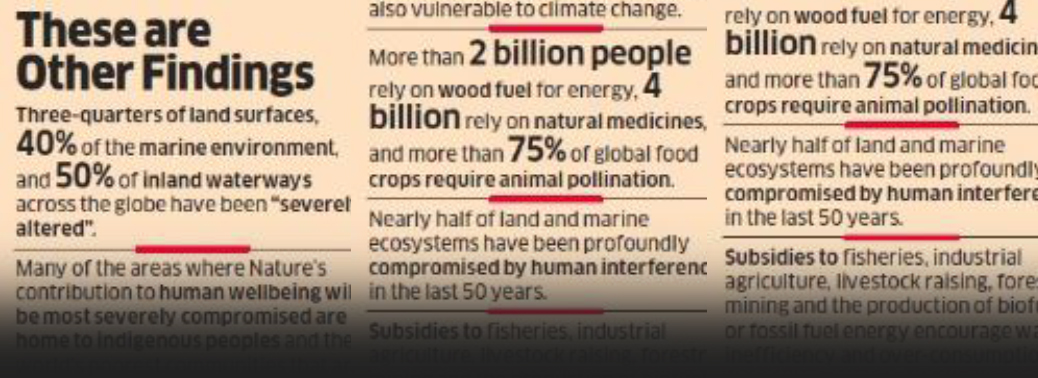Draft Un Report
27, Apr 2019

Prelims level : Environment
Mains level : GS-III Technology, Economic Development, Biodiversity, Environment, Security and Disaster Management
Why in News:
- Extinction of species due to loss of clean air, drinkable water, CO2-absorbing forests, pollinating insects, protein-rich fish and storm blocking mangroves says-UN Draft Report.
Background: Causes for biodiversity losses:
- The accelerated rates of species extinctions that the world is facing now are largely due to human activities. There are four major causes
- Habitat loss and fragmentation
- Over-exploitation
- Alien species invasions
- Co-extinctions
Habitat loss and fragmentation:
- Habitat loss and fragmentation is the most important cause driving animals and plants to extinction.
- The most intense examples of habitat loss come from tropical rain forests. The Amazon rain forests protecting probably millions of species is being cut and cleared for agricultural purposes or for conversion to grasslands for raising beef cattle.
- In addition to the total loss, the degradation of several habitats by pollution also threatens the existence of many species.
- When large habitats are broken up into small fragments due to anthropogenic activities, mammals and birds necessitating large territories and certain animals with migratory habits are severely affected, leading to population regressions.
Over-exploitation
- Humans have always depended on nature for food and shelter, etc.
- The population explosion is the major reason for the over-exploitation of available resources. Many species extinctions in the last 500 years such as Steller’s sea cow, passenger pigeon were due to overexploitation by humans.
- Currently, several marine fish populations around the world are over harvested, threatening the sustained existence of certain commercially important
Alien species invasions
- When alien species are introduced by chance or deliberately, some of them turn aggressive and cause the extinction of local The Nile perch introduced into Lake Victoria in East Africa led ultimately to the extinction of a naturally unique group of more than 200 species of cichlids fish in the lake. The illegal introduction of the African catfish, Clarias gariepinus for aquaculture purposes is posing a danger to the local catfishes.
Co-extinctions
- When a species becomes extinct, the flora and fauna related with it in an essential way also become
- When a host fish species becomes extinct, its unique assemblage of parasites also meets the same
How we all contribute every day :
- Electricity is the main source of power in urban areas. All our gadgets run on electricity generated mainly from thermal power These thermal power plants are run on fossil fuels (mostly coal) and are responsible for the emission of huge amounts of greenhouse gases and other pollutants.
- Cars, buses, and trucks are the principal ways by which goods and people are transported in most of our cities. These are run mainly on petrol or diesel, both fossil fuels. We generate large quantities of waste in the form of plastics that remain in the environment for many years and cause damage. We use a huge quantity of paper in our work at schools and in Timber is used in large quantities for construction of houses, which means that large areas of forest have to be cut down. A growing population has meant more and more mouths to feed.
- Because the land area available for agriculture is limited (and in fact, is actually shrinking as a result of ecological degradation!), high-yielding varieties of crop are being grown to increase the agricultural output from a given area of
- However, such high-yielding varieties of crops require large quantities of fertilizers; and more fertilizer means more emissions of nitrous oxide, both from the field into which it is put and the fertilizer industry that makes
- Pollution also results from the run-off of fertilizer into water bodies.
Plans and Policies in India for mitigation:
National Action Plan on Climate Change (NAPCC), 2008
- National Solar Mission (MNRE) – Goal for increasing the development of solar technologies such as increasing production of photo-voltaic to 1000 MW/year, Establishing the solar research center and promoting international
- National Mission for Enhanced Energy Efficiency (MoP)– Energy consumption reduction in industries; trading energy-savings certificates; energy incentives like lower taxes on energy- efficient appliances
- National Mission on Sustainable Habitat (MoHUA) – Better waste management; power from waste; extending energy conservation building code; incentivizing fuel-efficient vehicles; energy efficiency as part of urban planning; public transport promotion
- National Water Mission (MoWR) – Improving water use efficiency with the use of pricing and other measures
- National Mission for Sustaining the Himalayan Ecosystem (MoS&T) – conserve biodiversity, forest cover, and glaciers of the Himalayan region
- National Mission for “Green India” (MoEFCC) – expanding forest cover from 23% to 33% of India’s territory. National Mission for Sustainable Agriculture (MoA) – climate-resilient crops, crop insurance, sustainable agricultural practices.
- National Mission on Strategic Knowledge Platform for Climate Change (MoS&T) – Climate Science Research Fund; better climate modeling; international collaboration; private sector participation in the technologies for the adaptation and mitigation
Environmental Impact Assessment (EIA)
- Management tool to regulate the impact of industries on the environment for ensuring optimal use of natural resources for sustainable development
- Applicable for major projects like infrastructure, thermal and nuclear power, industries, mining etc. Industrial categorization (Red, Orange, Green and White) according to their impact to maintain balance between regulation and ease of doing business. White industries do not require EIA approval
Eco Sensitive Zone (ESZ)
- Objective is to create “shock absorbers” for the protected areas by regulating and managing the activities that threaten the forest areas e.g. Western Ghats
Other environment related laws:
- Environment (Protection) Act, 1986
- Forest (Conservation) Act, 1980
- Wildlife Protection Act, 1972
- Water (Prevention and Control of Pollution) Act, 1974
- Air (Prevention and Control of Pollution) Act, 1981 The Indian Forest Act, 1927
- National Green Tribunal Act, 2010.






